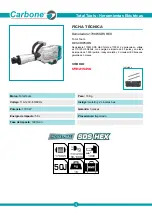
14
| English
1 609 92A 4J9 | (17.07.2018)
Bosch Power Tools
Orbital sander
GSS 230 AVE
GSS 280 AVE
Weight according to EPTA-Procedure
01:2014
kg
2.5
2.8
Protection class
/ II
/ II
The specifications apply to a rated voltage [U] of 230 V. These specifications may vary at different voltages and in country-specific models.
Noise/vibration information
GSS...
230 AVE
280 AVE
Noise emission values determined according to
EN 62841-2-4
.
Typically, the A-weighted noise level of the power tool is:
Sound pressure level
Sound power level
Uncertainty K
Wear hearing protection
dB(A)
dB(A)
dB
80
91
3
86
97
3
Total vibration values a
h
(triax vector sum) and uncertainty K determined according to
EN 62841-2-4
:
a
h
K
m/s
2
dB
2.5
1.5
2.5
1.5
The vibration level and noise emission value given in these
instructions have been measured in accordance with a
standardised measuring procedure detailed in EN 62841
and may be used to compare power tools. They may also be
used for a preliminary estimation of vibration and noise
emissions.
The given vibration level and noise emission value represent
the main applications of the power tool. However, if the
power tool is used for other applications, with different ap-
plication tools or is poorly maintained, the vibration level
and noise emission value may differ. This may significantly
increase the vibration and noise emissions over the total
working period.
To estimate vibration and noise emissions accurately, the
times when the tool is switched off or when it is running but
not actually being used should also be taken into account.
This may significantly reduce vibration and noise emissions
over the total working period.
Implement additional safety measures to protect the oper-
ator from the effects of vibration, such as servicing the
power tool and application tools, keeping the hands warm,
and organising workflows correctly.
Assembly
u
Pull the plug out of the socket before carrying out any
work on the power tool.
Dust/chip extraction
The dust from materials such as lead paint, some types of
wood, minerals and metal can be harmful to human health.
Touching or breathing in this dust can trigger allergic reac-
tions and/or cause respiratory illnesses in the user or in
people in the near vicinity.
Certain dusts, such as oak or beech dust, are classified as
carcinogenic, especially in conjunction with wood treatment
additives (chromate, wood preservative). Materials contain-
ing asbestos may only be machined by specialists.
– Use a dust extraction system that is suitable for the ma-
terial wherever possible.
– Provide good ventilation at the workplace.
– It is advisable to wear a P2 filter class breathing mask.
The regulations on the material being machined that apply in
the country of use must be observed.
u
Avoid dust accumulation at the workplace.
Dust can
easily ignite.
Self-generated dust extraction with dust box
(see figures I–M)
Slide the dust box
(7)
onto the extraction outlet
(22)
. Turn
the dust box in such a manner that its recesses face against
the tips on the extraction outlet and the dust box can be felt
to engage.
You can easily check the filling level of the dust box
(7)
through the transparent container.
To empty the dust box
(7)
, rotate slightly and pull it back.
Unscrew the filter element
(6)
and pull it out of the dust box
(7)
. Empty the dust box.
Gently tap the filter element
(6)
against a solid surface to
loosen the dust. Use a soft brush to clean the flaps of the fil-
ter element
(6)
.
Note:
In order to ensure optimum dust extraction, empty the
dust box
(7)
in good time and clean the filter element
(6)
regularly.
When working on vertical surfaces, hold the power tool with
the dust box
(7)
facing downwards.
External dust extraction (see figure N)
Fit a dust extraction hose
(23)
onto the extraction outlet
(22)
. Mount the vacuum hose onto the extraction outlet (as















































